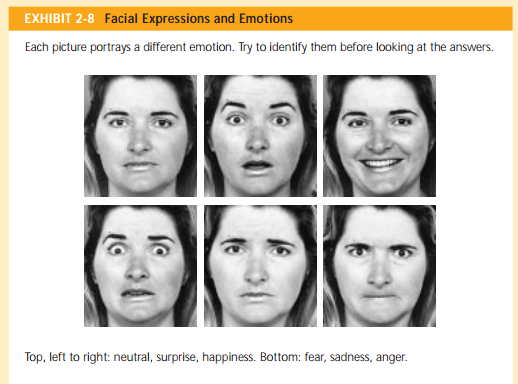Question: Reading Emotions
Understanding another person's felt emotions is very difficult. But we can learn to read others' displayed emotions.106 We do this by focusing on verbal, nonverbal, and paralanguage cues. The easiest way to find out what someone is feeling is to ask. Saying something as simple as "Are you OK? What's the problem?" can often provide you with the information to assess an individual's emotional state. But relying on a verbal response has two drawbacks. First, almost all of us conceal our emotions to some extent for privacy and to reflect social expectations. So we might be unwilling to share our true feelings. Second, even if we want to verbally convey our feelings, we may be unable to do so. As we noted earlier, some people have difficulty understanding their own emotions and, hence, are unable to express them verbally. So, at best, verbal responses provide only partial information.
You are talking with a co-worker. Does the fact that his back is rigid, his teeth are clenched, and his facial muscles tight tell you something about his emotional state? It probably should. Facial expressions, gestures, body movements, and physical distance are nonverbal cues that can provide additional insights into what a person is feeling. The facial expressions shown in Exhibit 2-8, for instance, are a window into a person's feelings. Notice the difference in facial features: the height of the cheeks, the raising or lowering of the brow, the turn of the mouth, the positioning of the lips, and the configuration of muscles around the eyes. Even something as subtle as the distance someone chooses to put between him- or herself and you can convey how much intimacy, aggressiveness, repugnance, or withdrawal that person feels. When you speak with someone, you may notice a sharp change in the tone of her voice and the speed at which she speaks. You are tapping into the third source of information on a person's emotions-paralanguage. This is communication that goes beyond the specific spoken words.
It includes pitch, amplitude, rate, and voice quality of speech. Paralanguage reminds us that people convey their feelings not only in what they say, but also in how they say it.
Assessing Skills: After you've read this chapter, take the following SelfAssessments on your enclosed CD-ROM:
1. What's My Basic Personality?
2. What's My Emotional Intelligence Score?

Practising Skills: Part A. Form groups of two. Each person is to spend a couple of minutes thinking of a time in the past when she or he was emotional about something. Examples might include being upset with a parent, sibling, or friend; being excited or disappointed about an academic or athletic achievement; being angry with someone over an insult or slight; being disgusted by something someone has said or done; or being happy because of something good that happened. Do not share this event with the other person in your group.
Part B. Now you will conduct two role plays. Each will be an interview. In the first, one person will play the interviewer and the other will play the job applicant. The job is for a summer management internship with a large retail chain. Each role play will last no longer than 10 minutes. The interviewer is to conduct a normal job interview, except you are to continually rethink the emotional episode you envisioned in Part A. Try hard to convey this emotion while, at the same time, being professional in interviewing the job applicant.
Part C. Now reverse positions for the second role play. The interviewer becomes the job applicant and vice versa. The new interviewer will conduct a normal job interview, except that he or she will continually rethink the emotional episode chosen in Part A.
Part D. Spend 10 minutes analyzing the interview, with specific attention focused on these questions: What emotion(s) do you think the other person was conveying? What cues did you pick up? How accurate were you in reading those cues?